#I am Half Sick of Shadows said the Lady of Shalott
Text

-I am Half Sick of Shadows, said the Lady of Shalott-
107 notes
·
View notes
Text
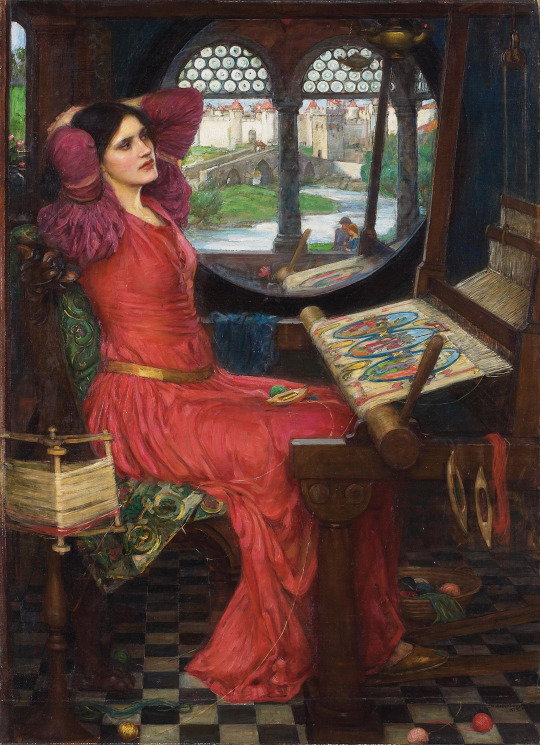
John William Waterhouse (Italian-born British, 1849-1917)
I am half-sick of shadows, said the Lady of Shalott, 1915
Art Gallery of Ontario
#I am half sick of shadows said the lady of shalott#John William Waterhouse#art#italian#british#island kingdom#england#british art#english art#the lady of shalott#1800s#fine art#european art#classical art#european#europe#oil painting#fine arts#europa
528 notes
·
View notes
Text
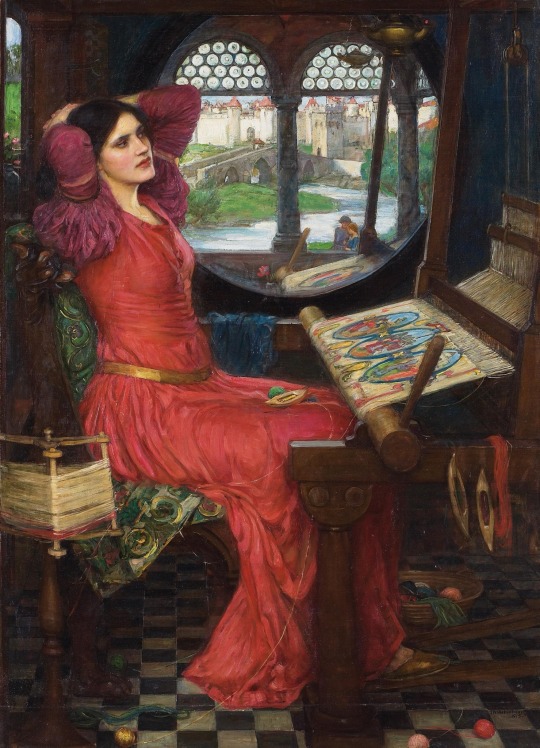
I am Half Sick of Shadows, said the Lady of Shalott
John William Waterhouse
1915
#John William Waterhouse#art#artist#painter#painting#I am Half Sick of Shadows said the Lady of Shalott
33 notes
·
View notes
Text
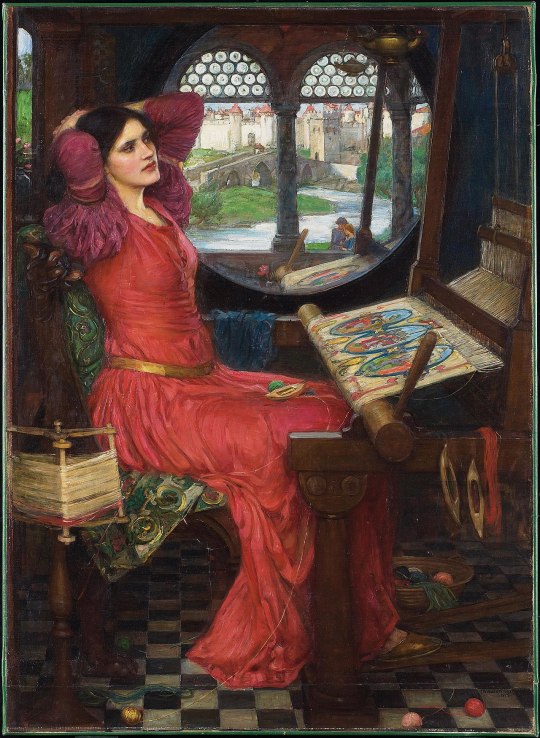
John William Waterhouse (English, 1849-1917)
I am Half-Sick of Shadows, said the Lady of Shalott
674 notes
·
View notes
Text
...No time hath she to sport and play:
A charmèd web she weaves alway.
A curse is on her, if she stay
Her weaving, either night or day,
To look down to Camelot.
She knows not what the curse may be;
Therefore she weaveth steadily,
Therefore no other care hath she,
The Lady of Shalott...

....But in her web she still delights
To weave the mirror's magic sights:
For often thro' the silent nights
A funeral, with plumes and lights
And music, came from Camelot.
Or, when the moon was overhead,
Came two young lovers, lately wed:
"I am half-sick of shadows," said
The Lady of Shalott.
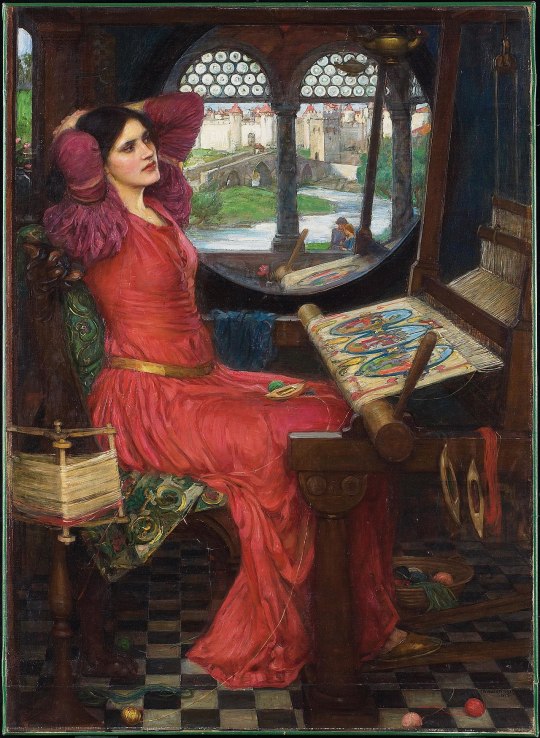
A bowshot from her bower-eaves.
He rode between the barley-sheaves:
The sun came dazzling thro' the leaves,
And flamed upon the brazen greaves
Of bold Sir Lancelot.
A redcross knight for ever kneeled
To a lady in his shield,
That sparkled on the yellow field,
Beside remote Shalott....
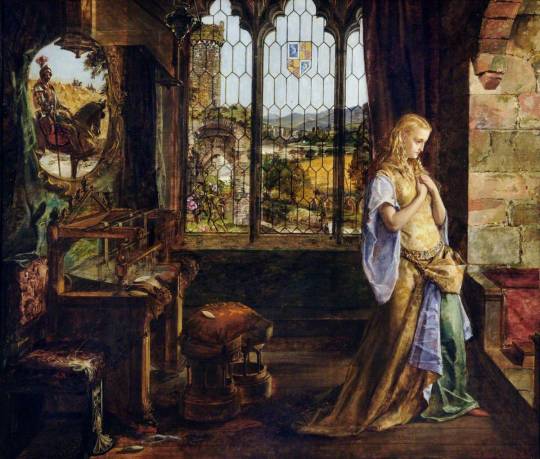
...She left the web: she left the loom:
She made three paces thro' the room:
She saw the waterflower bloom:
She saw the helmet and the plume:
She looked down to Camelot.
Out flew the web, and floated wide,
The mirror cracked from side to side,
"The curse is come upon me," cried
The Lady of Shalott.
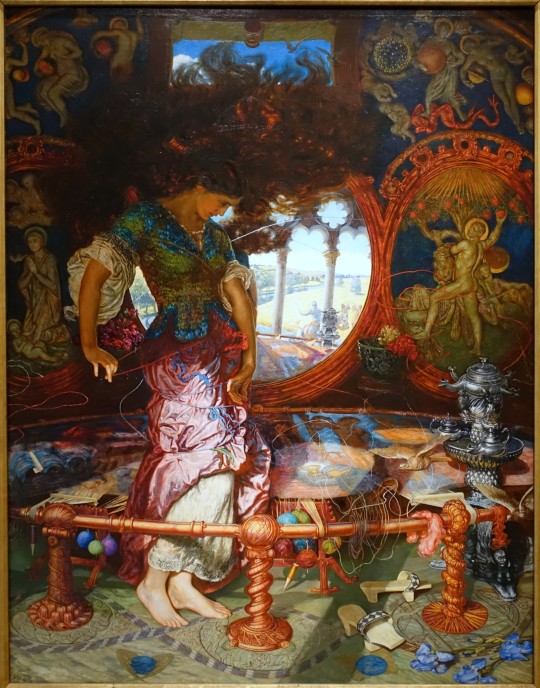
On either side the river lie
Long fields of barley and of rye,
That clothe the wold, and meet the sky.
And thro' the field the road runs by
To manytowered Camelot.
The yellowleavèd waterlily,
The green-sheathèd daffodilly,
Tremble in the water chilly,
Round about Shalott....
...With a steady, stony glance—
Like some bold seer in a trance,
Beholding all his own mischance,
Mute, with a glassy countenance—
She looked down to Camelot.
It was the closing of the day,
She loosed the chain, and down she lay,
The broad stream bore her far away,
The Lady of Shalott...

...Under tower and balcony,
By gardenwall and gallery,
A pale, pale corpse she floated by,
Deadcold, between the houses high,
Dead into towered Camelot.
Knight and burgher, lord and dame,
To the plankèd wharfage came:
Below the stern they read her name,
"The Lady of Shalott."...
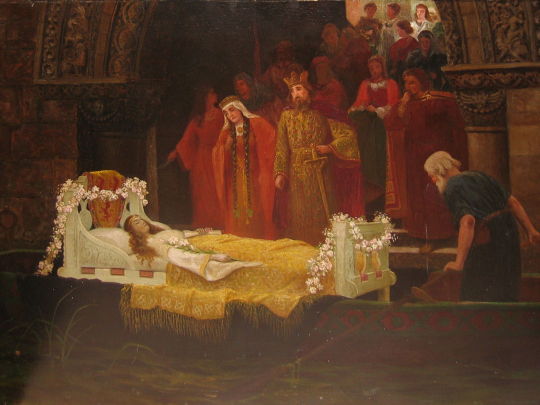
Text: Excerpts from "The Lady Of Shalott" by Alfred Tennyson, 1833
Images: Howard Pyle, 1881; John William Waterhouse, 1915; William Maw Egley, 1858; William Holman Hunt, c. 1905; John William Waterhouse, 1888; Edmund Blair Leighton, c. 1887
#I am having feelings again#I'd love to do a painting on this theme myself but I have not had much success painting people#arthurian legend#pre-raphaelites#it is about how it's safer to keep love at a distance than experience it yourself#but it can become unbearable#when knighthood was in flower
150 notes
·
View notes
Text
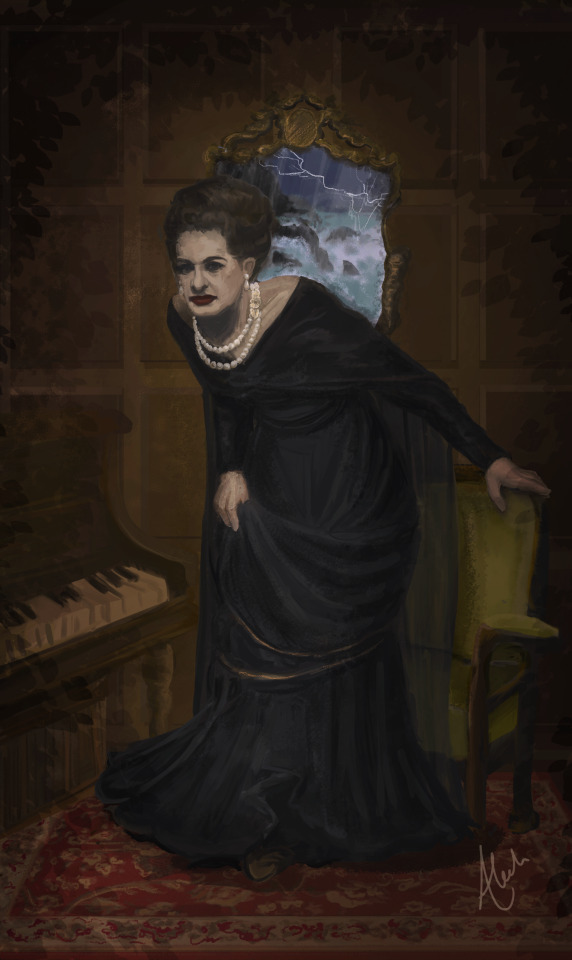
'I am half sick of shadows,' said The Lady of Shalott.
109 notes
·
View notes
Text

Title: I am Half Sick of Shadows, said the Lady of Shalott
Artist: John William Waterhouse
Date: 1915
Style: Romanticism
Genre: Literary Painting
204 notes
·
View notes
Photo

helaena targaryen + the lady of shalott
To weave the mirror’s magic sights,
For often thro’ the silent nights
A funeral, with plumes and lights
And music, came from Camelot:
Or when the moon was overhead
Came two young lovers lately wed;
‘I am half sick of shadows,’ said
The Lady of Shalott.
She left the web, she left the loom
She made three paces thro’ the room
She saw the water-flower bloom,
She saw the helmet and the plume,
She look’d down to Camelot.
Out flew the web and floated wide;
The mirror crack’d from side to side;
'The curse is come upon me,’ cried
The Lady of Shalott.
With a steady stony glance—
Like some bold seer in a trance,
Beholding all his own mischance,
Mute, with a glassy countenance—
She look’d down to Camelot.
It was the closing of the day:
She loos’d the chain, and down she lay;
The broad stream bore her far away,
The Lady of Shalott
#helaena targaryen#the lady of shalott#alfred lord tennyson#my aesthetic#hotd aesthetic#my edits#house of the dragon
55 notes
·
View notes
Text
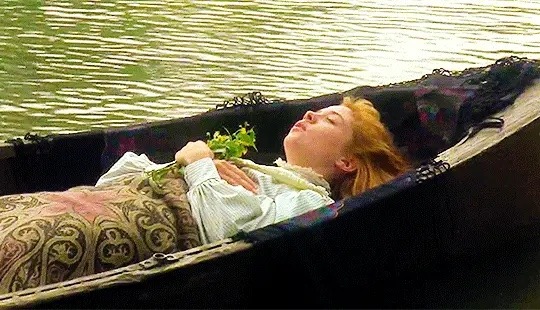
My URL is a tongue-in-cheek reference to Anne Shirley, specifically when she play acts as the Lilymaid, Elaine, from Lord Alfred Tennyson’s poem, The Lady of Shalott.
Her annoyance that Gilbert Blythe of all people should find her clinging to the pylons and rescue her, and worse that her friends should find it so romantic, endears this scene to me. It’s one of my most favorites from the entire series, right up there with “Rilla MY Rilla?”.
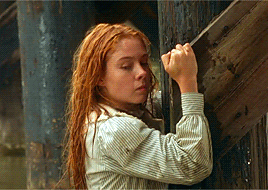

Wistfulweaverwoman specifically comes from the line “there she weaves by night and day, a magic web with colors gay”, while my AO3 is Lilymaid.
Here is the poem in its entirety:
The Lady of Shalott (1842)
BY ALFRED, LORD TENNYSON
Part I
On either side the river lie
Long fields of barley and of rye,
That clothe the wold and meet the sky;
And thro' the field the road runs by
To many-tower'd Camelot;
And up and down the people go,
Gazing where the lilies blow
Round an island there below,
The island of Shalott.
Willows whiten, aspens quiver,
Little breezes dusk and shiver
Thro' the wave that runs for ever
By the island in the river
Flowing down to Camelot.
Four gray walls, and four gray towers,
Overlook a space of flowers,
And the silent isle imbowers
The Lady of Shalott.
By the margin, willow veil'd,
Slide the heavy barges trail'd
By slow horses; and unhail'd
The shallop flitteth silken-sail'd
Skimming down to Camelot:
But who hath seen her wave her hand?
Or at the casement seen her stand?
Or is she known in all the land,
The Lady of Shalott?
Only reapers, reaping early
In among the bearded barley,
Hear a song that echoes cheerly
From the river winding clearly,
Down to tower'd Camelot:
And by the moon the reaper weary,
Piling sheaves in uplands airy,
Listening, whispers " 'Tis the fairy
Lady of Shalott."
Part II
There she weaves by night and day
A magic web with colours gay.
She has heard a whisper say,
A curse is on her if she stay
To look down to Camelot.
She knows not what the curse may be,
And so she weaveth steadily,
And little other care hath she,
The Lady of Shalott.
And moving thro' a mirror clear
That hangs before her all the year,
Shadows of the world appear.
There she sees the highway near
Winding down to Camelot:
There the river eddy whirls,
And there the surly village-churls,
And the red cloaks of market girls,
Pass onward from Shalott.
Sometimes a troop of damsels glad,
An abbot on an ambling pad,
Sometimes a curly shepherd-lad,
Or long-hair'd page in crimson clad,
Goes by to tower'd Camelot;
And sometimes thro' the mirror blue
The knights come riding two and two:
She hath no loyal knight and true,
The Lady of Shalott.
But in her web she still delights
To weave the mirror's magic sights,
For often thro' the silent nights
A funeral, with plumes and lights
And music, went to Camelot:
Or when the moon was overhead,
Came two young lovers lately wed:
"I am half sick of shadows," said
The Lady of Shalott.
Part III
A bow-shot from her bower-eaves,
He rode between the barley-sheaves,
The sun came dazzling thro' the leaves,
And flamed upon the brazen greaves
Of bold Sir Lancelot.
A red-cross knight for ever kneel'd
To a lady in his shield,
That sparkled on the yellow field,
Beside remote Shalott.
The gemmy bridle glitter'd free,
Like to some branch of stars we see
Hung in the golden Galaxy.
The bridle bells rang merrily
As he rode down to Camelot:
And from his blazon'd baldric slung
A mighty silver bugle hung,
And as he rode his armour rung,
Beside remote Shalott.
All in the blue unclouded weather
Thick-jewell'd shone the saddle-leather,
The helmet and the helmet-feather
Burn'd like one burning flame together,
As he rode down to Camelot.
As often thro' the purple night,
Below the starry clusters bright,
Some bearded meteor, trailing light,
Moves over still Shalott.
His broad clear brow in sunlight glow'd;
On burnish'd hooves his war-horse trode;
From underneath his helmet flow'd
His coal-black curls as on he rode,
As he rode down to Camelot.
From the bank and from the river
He flash'd into the crystal mirror,
"Tirra lirra," by the river
Sang Sir Lancelot.
She left the web, she left the loom,
She made three paces thro' the room,
She saw the water-lily bloom,
She saw the helmet and the plume,
She look'd down to Camelot.
Out flew the web and floated wide;
The mirror crack'd from side to side;
"The curse is come upon me," cried
The Lady of Shalott.
Part IV
In the stormy east-wind straining,
The pale yellow woods were waning,
The broad stream in his banks complaining,
Heavily the low sky raining
Over tower'd Camelot;
Down she came and found a boat
Beneath a willow left afloat,
And round about the prow she wrote
The Lady of Shalott.
And down the river's dim expanse
Like some bold seër in a trance,
Seeing all his own mischance—
With a glassy countenance
Did she look to Camelot.
And at the closing of the day
She loosed the chain, and down she lay;
The broad stream bore her far away,
The Lady of Shalott.
Lying, robed in snowy white
That loosely flew to left and right—
The leaves upon her falling light—
Thro' the noises of the night
She floated down to Camelot:
And as the boat-head wound along
The willowy hills and fields among,
They heard her singing her last song,
The Lady of Shalott.
Heard a carol, mournful, holy,
Chanted loudly, chanted lowly,
Till her blood was frozen slowly,
And her eyes were darken'd wholly,
Turn'd to tower'd Camelot.
For ere she reach'd upon the tide
The first house by the water-side,
Singing in her song she died,
The Lady of Shalott.
Under tower and balcony,
By garden-wall and gallery,
A gleaming shape she floated by,
Dead-pale between the houses high,
Silent into Camelot.
Out upon the wharfs they came,
Knight and burgher, lord and dame,
And round the prow they read her name,
The Lady of Shalott.
Who is this? and what is here?
And in the lighted palace near
Died the sound of royal cheer;
And they cross'd themselves for fear,
All the knights at Camelot:
But Lancelot mused a little space;
He said, "She has a lovely face;
God in his mercy lend her grace,
The Lady of Shalott."
#also wistfulweaverwoman is a nod to my love of writing#to weave magical stories#also reminds me of the moirai weaving the threads of life#wistfulweaverwoman#lilymaid#anne of green gables#anne shirley
17 notes
·
View notes
Text
On either side the river lie
Long fields of barley and of rye,
That clothe the wold and meet the sky;
And thro' the field the road runs by
To many-tower'd Camelot;
The yellow-leaved waterlily
The green-sheathed daffodilly
Tremble in the water chilly
Round about Shalott.
Willows whiten, aspens shiver.
The sunbeam showers break and quiver
In the stream that runneth ever
By the island in the river
Flowing down to Camelot.
Four gray walls, and four gray towers
Overlook a space of flowers,
And the silent isle imbowers
The Lady of Shalott.
Underneath the bearded barley,
The reaper, reaping late and early,
Hears her ever chanting cheerly,
Like an angel, singing clearly,
O'er the stream of Camelot.
Piling the sheaves in furrows airy,
Beneath the moon, the reaper weary
Listening whispers, ' 'Tis the fairy,
Lady of Shalott.'
The little isle is all inrail'd
With a rose-fence, and overtrail'd
With roses: by the marge unhail'd
The shallop flitteth silken sail'd,
Skimming down to Camelot.
A pearl garland winds her head:
She leaneth on a velvet bed,
Full royally apparelled,
The Lady of Shalott.
Part II
No time hath she to sport and play:
A charmed web she weaves alway.
A curse is on her, if she stay
Her weaving, either night or day,
To look down to Camelot.
She knows not what the curse may be;
Therefore she weaveth steadily,
Therefore no other care hath she,
The Lady of Shalott.
She lives with little joy or fear.
Over the water, running near,
The sheepbell tinkles in her ear.
Before her hangs a mirror clear,
Reflecting tower'd Camelot.
And as the mazy web she whirls,
She sees the surly village churls,
And the red cloaks of market girls
Pass onward from Shalott.
Sometimes a troop of damsels glad,
An abbot on an ambling pad,
Sometimes a curly shepherd lad,
Or long-hair'd page in crimson clad,
Goes by to tower'd Camelot:
And sometimes thro' the mirror blue
The knights come riding two and two:
She hath no loyal knight and true,
The Lady of Shalott.
But in her web she still delights
To weave the mirror's magic sights,
For often thro' the silent nights
A funeral, with plumes and lights
And music, came from Camelot:
Or when the moon was overhead
Came two young lovers lately wed;
'I am half sick of shadows,' said
The Lady of Shalott.
Part III
A bow-shot from her bower-eaves,
He rode between the barley-sheaves,
The sun came dazzling thro' the leaves,
And flam'd upon the brazen greaves
Of bold Sir Lancelot.
A red-cross knight for ever kneel'd
To a lady in his shield,
That sparkled on the yellow field,
Beside remote Shalott.
The gemmy bridle glitter'd free,
Like to some branch of stars we see
Hung in the golden Galaxy.
The bridle bells rang merrily
As he rode down from Camelot:
And from his blazon'd baldric slung
A mighty silver bugle hung,
And as he rode his armour rung,
Beside remote Shalott.
All in the blue unclouded weather
Thick-jewell'd shone the saddle-leather,
The helmet and the helmet-feather
Burn'd like one burning flame together,
As he rode down from Camelot.
As often thro' the purple night,
Below the starry clusters bright,
Some bearded meteor, trailing light,
Moves over green Shalott.
His broad clear brow in sunlight glow'd;
On burnish'd hooves his war-horse trode;
From underneath his helmet flow'd
His coal-black curls as on he rode,
As he rode down from Camelot.
From the bank and from the river
He flash'd into the crystal mirror,
'Tirra lirra, tirra lirra:'
Sang Sir Lancelot.
She left the web, she left the loom
She made three paces thro' the room
She saw the water-flower bloom,
She saw the helmet and the plume,
She look'd down to Camelot.
Out flew the web and floated wide;
The mirror crack'd from side to side;
'The curse is come upon me,' cried
The Lady of Shalott.
Part IV
In the stormy east-wind straining,
The pale yellow woods were waning,
The broad stream in his banks complaining,
Heavily the low sky raining
Over tower'd Camelot;
Outside the isle a shallow boat
Beneath a willow lay afloat,
Below the carven stern she wrote,
The Lady of Shalott.
A cloudwhite crown of pearl she dight,
All raimented in snowy white
That loosely flew (her zone in sight
Clasp'd with one blinding diamond bright)
Her wide eyes fix'd on Camelot,
Though the squally east-wind keenly
Blew, with folded arms serenely
By the water stood the queenly
Lady of Shalott.
With a steady stony glance—
Like some bold seer in a trance,
Beholding all his own mischance,
Mute, with a glassy countenance—
She look'd down to Camelot.
It was the closing of the day:
She loos'd the chain, and down she lay;
The broad stream bore her far away,
The Lady of Shalott.
As when to sailors while they roam,
By creeks and outfalls far from home,
Rising and dropping with the foam,
From dying swans wild warblings come,
Blown shoreward; so to Camelot
Still as the boathead wound along
The willowy hills and fields among,
They heard her chanting her deathsong,
The Lady of Shalott.
A longdrawn carol, mournful, holy,
She chanted loudly, chanted lowly,
Till her eyes were darken'd wholly,
And her smooth face sharpen'd slowly,
Turn'd to tower'd Camelot:
For ere she reach'd upon the tide
The first house by the water-side,
Singing in her song she died,
The Lady of Shalott.
Under tower and balcony,
By garden wall and gallery,
A pale, pale corpse she floated by,
Deadcold, between the houses high,
Dead into tower'd Camelot.
Knight and burgher, lord and dame,
To the planked wharfage came:
Below the stern they read her name,
The Lady of Shalott.
They cross'd themselves, their stars they blest,
Knight, minstrel, abbot, squire, and guest.
There lay a parchment on her breast,
That puzzled more than all the rest,
The wellfed wits at Camelot.
'The web was woven curiously,
The charm is broken utterly,
Draw near and fear not,—this is I,
The Lady of Shalott.'
9 notes
·
View notes
Photo

John William Waterhouse - I am half-sick of shadows, said the Lady of Shalott (1915)
But in her web she still delights
To weave the mirror's magic sights,
For often thro' the silent nights
A funeral, with plumes and lights
And music, went to Camelot:
Or when the moon was overhead,
Came two young lovers lately wed:
"I am half sick of shadows," said
The Lady of Shalott.
The Lady of Shalott (extract), Lord Alfred Tennyson (1842)
26 notes
·
View notes
Text
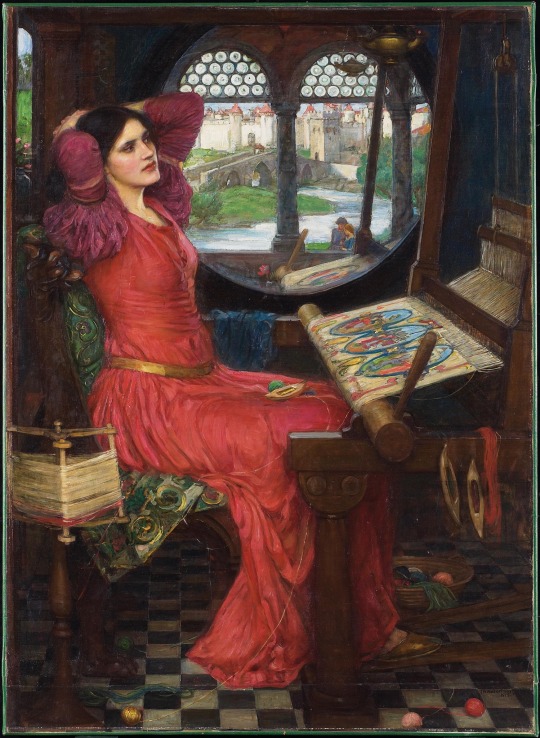
I am half sick of shadows, said the Lady of Shalott - John William Waterhouse, 1916.
12 notes
·
View notes
Text
The Lady of Shalott and Elain Archeron
This will be a comparative analysis of Alfred Tennyson’s poem The Lady of Shalott (1842), three paintings by Waterhouse, and Elain Archeron (because why not?)
I recently read The Lady of Shalott for the first time in years and I couldn’t help but see the similarities between the character in Tennyson’s poem and Elain, so I decided to write this analysis since I love both the poem, the art and our flower girl. There will also be mentions of Elriel.
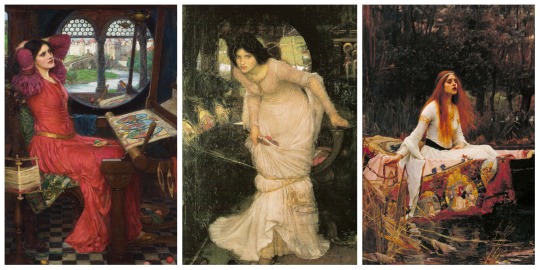
Synopsis:
In short, the poem tells the story of the Lady of Shalott, also known as Elaine of Astolat (very fitting name…).
In the beginning of this Victorian poem, we are introduced to the Lady (this is what I will call her in this text) and the setting. We are told that she is cursed (but we do not know what the curse really is). She is locked in a tower and not allowed to look out the window. Instead, she has a mirror that reflects the world outside. She watches the world through that mirror and weaves what she sees.
In the middle of the poem, the Lady sees a handsome man in her mirror - Lancelot. And for the first time in her life, she turns around to look out the window to behold him. The mirror cracks and the Lady knows that the curse is upon her.
She runs out of the tower and writes her name on a small boat. Knowing that she is cursed, she gets in the boat and lets it float away, and there, on the river, she dies a peaceful death. When the boat enters Camelot, Lancelot sees her face and says, "She has a lovely face; God in his mercy lend her grace, The Lady of Shalott."
1. I am half sick of shadows / To see what cannot be seen

This painting by Waterhouse is called “I am half sick of Shadows, said the Lady of Shalott.”
In this stanza, we can see where Waterhouse found his inspiration:
But in her web she still delights
To weave the mirror's magic sights,
For often thro' the silent nights
A funeral, with plumes and lights
And music, went to Camelot:
Or when the moon was overhead,
Came two young lovers lately wed:
"I am half sick of shadows," said
The Lady of Shalott.
As previously mentioned, the Lady is cursed and forced to sit in her tower and weave what she sees in the mirror. She had no companions and is doomed to spend her life alone, watching but never participating in life. In Waterhouse’s painting, we can see two lovers reflected in the mirror. Something that is worth noting is that we can also see a red poppy in the mirror (at the bottom, by her loom), but the flower cannot be seen in the foreground. The red poppy symbolizes eternal sleep and foreshadows her fate.
In the poem, it is clear that the Lady is tired of only seeing the shadows of reality. This image of the lady locked in a tower can represent the Victorian ideal of the ideal woman: virginal, mysterious and dedicated to womanly tasks. She is a passive object.
Elain:
At the beginning of ACOWAR, Elain spends most of her time in her room in the House of Wind. She looks out the window, maybe looking for the life she was forced to leave behind? She sees herself as cursed after being forced into the cauldron. Her curse is that she can see things others cannot. Her mind produces images that make no sense to her and the people around her wonder if she might be broken. She does not participate in ordinary life and her life is only a shadow of what it once was. She was engaged to be married to a man she thought she loved who loved her back. Now, she’s forced to watch happy couples and happy people when she herself is miserable. Her mate’s attempts to get her attention are not making things better.
We later find out that Elain is a seer, which brings my attention back to the poppy. The Lady is only allowed to look in the mirror and there, she can see her fate in the small flower. She can see her curse - just like Elain can see things that haven't happened yet. Maybe she can also see her own curse?
Just like the Lady of Shalott, Elain has been called passive. People accuse her of not ‘doing anything’ and that she is boring because she enjoys ‘womanly tasks’. And yes, in the beginning of ACOWAR, she was more passive, which can be explained by the fact that she did not understand her own mind.
2. The mirror crack'd from side to side / To see or be seen
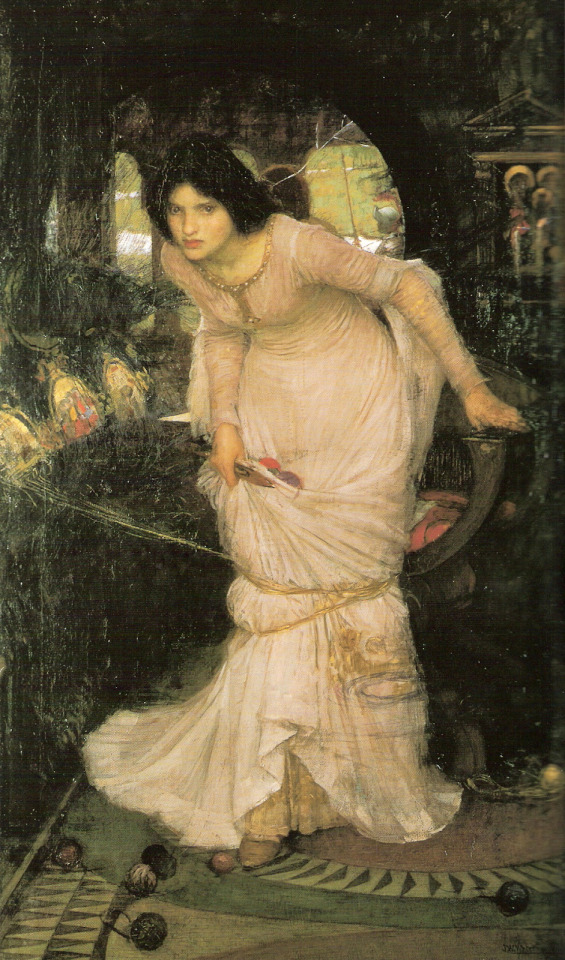
In this painting, The Lady of Shalott looking at Lancelot, we can see the cracked mirror in the background. The Lady is looking right at us and she is tangled in the threads of her tapestry. One could also see this as the Lady being tangled in the threads of her own fate. In the mirror, we can also see Lancelot as he rides by.
In the poem, the Lady sees Lancelot and falls in love instantaneously. In the following stanza, we can see the Lady’s reaction to seeing the handsome knight:
She left the web, she left the loom,
She made three paces thro' the room,
She saw the water-lily bloom,
She saw the helmet and the plume,
She look'd down to Camelot.
Out flew the web and floated wide;
The mirror crack'd from side to side;
"The curse is come upon me," cried
The Lady of Shalott.
Here, the lady is no longer passive. She is actively “choosing to defy her confinement, in pursuit of her own desires” (see source). As soon as she turns, the mirror cracks and she knows that the curse is upon her. She knew that the curse would come, yet she decided to go against everything she knew and believed, just for a glance of the man she loved.
In Victorian times, this might have been seen as the lady being cursed for giving up on her ideals. She, and women in general, were supposed to be virginal, passive and obedient. When she looks out that window to look at Lancelot, she is leaving these ideals behind. She is now a woman actively choosing her own path and being in control of her own sexuality. She is longing for something, for someone, and she allows herself to go after what she wants - even if it might destroy her.
Elain:
In ACOWAR, Elain is also drawn to a particular man/male - Azriel. She lets him carry her and take her out to the garden and when she sees his hands/siphons, she tells him that they’re beautiful. This is Elain being more active than passive. She is talking to Azriel, engaging with him.
Everyone else thinks that she is cursed and that there’s something wrong with her (Feyre calls Madja to examine Elain, Lucien tries to feel what is wrong with her through the mating bond and Nesta guards Elain at all times). Everyone is protective of Elain, even though they don’t understand her. They don’t truly see her. Like when she asks Lucien “I can hear your heart. Can you hear mine?” and he answers that he cannot. Here, one might interpret this as if Elain knows what’s in Lucien’s heart, but he does not know what’s in her heart. Her fate is tied to Lucien, yet he does not see her truth.
Then, one person does see her. Azriel is the one who figures out that Elain is a seer and as soon as he utters those words, something changes. Elain has been isolating (just like the Lady), seeing things only as shadows (just like the Lady of Shalott) and she is changed after someone actually sees her. And after that, she can see herself more clearly. She can understand her curse.
In the poem, the Lady understands her curse after she sees Lancelot. Although he does not see her in her tower, she decided to defy her fate because of the love she felt for Lancelot. And by leaving the tower, she is also making herself seen. She is not hidden in the shadows anymore and she is not afraid of what’s to come. She is actively making her own choices - even if they mean death.
After Azriel tells her that she is a seer, Elain takes on a more active role. She, too, goes from passive to active. She, too, defies her fate. She tells Feyre that she does not want a mate. She joins the battle against Hybern. She kills the King of Hybern.
She is tangled in the threads of her fate – her past where she was engaged to Graysen, her present where she is tied to Lucien, and her future that is yet to be written. But now, she can be an active participant in what her future will be. In ACOFAS, we see Elain dismiss Lucien in favor of spending an entire evening with Azriel, where she tells him about her plans for the garden. Before that, Azriel helps her carry a tray of potatoes. They see each other - and they are actively seeking out each other’s company - even though they shouldn’t.
3. Like some bold seër in a trance / See me
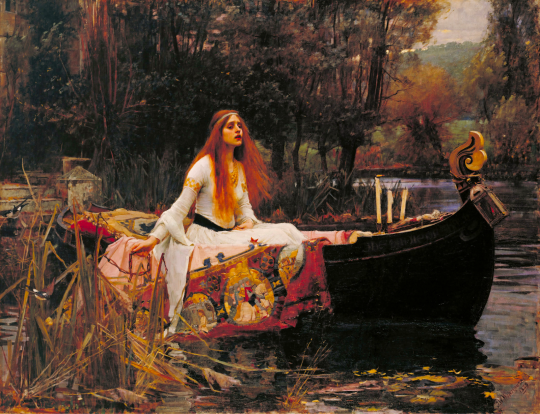
First and foremost, when the Lady leaves the tower and sits down in the boat, she looks toward Camelot and Tennyson describes her like this: Like some bold seër in a trance. Which is…interesting.
In this last part of the poem, the Lady flees the tower and finds a boat that can take her to Camelot. In Waterhouse’s painting, we can see the tapestry she has woven draped over the boat (in the smaller images on the tapestry we can see the lady herself and Lancelot surrounded by other knights).
On the boat, we can also see a crucifix (which symbolizes sacrifice) and three candles - two have been blown out already, which might indicate that her life is about to end. She is just about to let go of the chain and let the boat take her to Camelot - to Lancelot. And on her journey, she dies.
This is the last stanza of the poem:
Who is this? and what is here?
And in the lighted palace near
Died the sound of royal cheer;
And they cross'd themselves for fear,
All the knights at Camelot:
But Lancelot mused a little space;
He said, "She has a lovely face;God in his mercy lend her grace, The Lady of Shalott."
When she reaches Camelot, she is already dead. The other knights “cross’d themselves for fear” but Lancelot looks at her and “muses a little space” and sends a prayer her way. And he is also probably the first person to ever say her name. Although she is dead, she can finally be seen. She can finally be a part of the outside world. And in death, her love saw her.
One can analyze this poem in many ways. You might read it and think about the woman’s role in Victorian society and therefore see the theme as “freedom comes at a cost” - Yes, the Lady found her freedom, but as soon as she left her ‘morals’ behind, she died.
One can also focus on the isolation the Lady of Shalott was subjected to. The harm of this isolation broke her and she eventually chose death just to get out of her loneliness (=one of my favorite interpretations).
And then, for the sake of this analysis, I also want to bring up a different interpretation: “The Lady of Shalott's escape from her tower as an act of defiance, a symbol of female empowerment” (see source; Christine Poulson).
In this last interpretation, the Lady is breaking free from the norms and chains holding her hostage in a life she does not want. The lady is also coming to terms with her own female sexuality. Christine Poulson also writes that “the depiction of death has also been interpreted as sleep” and goes on to explain that sleep “has a connotation of physical abandonment and vulnerability, which can either suggest sexual fulfillment or be a metaphor for virginity.”
Elain:
Firstly, just like the Lady of Shalott, Elain has been told that she has “a lovely face” her entire life. This is something that defines her - she is the most beautiful sister. And as mentioned previously, Azriel is the first to truly see Elain, just like Lancelot is the first to truly see the Lady.
Now, I do not think that Elain will lay down in a boat and die. But I do see the similarities between Elain and the Lady of Shalott here, especially when considering this last interpretation above. When the Lady leaves the tower and ‘dies’ this can be interpreted as sexual fulfillment. As mentioned earlier, the Lady goes from passive to active - actively choosing to act on her feelings for Lancelot.
And as we can see in The Bonus Chapter from ACOSF (Azriel’s POV), Elain is also actively going after the man she wants. He is not what fate/the cauldron has chosen for her, but he is what she has chosen for herself.
When he bends down to kiss her, Elain gives him “offer and permission”. She wants him. She yearns for him. She is aroused by him. By choosing him, she is leaving her old life as a human behind. She told Feyre that she doesn’t want a mate or a male, showing the readers that she was still mourning her human life. She wanted a man, not a male. Yet here she is, choosing a male that is not her mate. She is not only leaving her human life behind, she is also defying the life fate chose for her.
In the poem, the lady dies because the curse was upon her. Yet, we still don’t know what this curse was. Was it really that she would die if she looked out that window? Or was the real curse knowing that she couldn’t have what she wanted?
In the legend, we can read about Lancelot’s love for Guinevere (who is married to King Arthur) and Elaine of Astolat therefore died of a broken heart. Her curse was to love but never being loved in return. She sacrificed everything for him, only to find that he loved someone else.
In the Bonus Chapter, Azriel leaves Elain in the hallway. She doesn't know why, but we can assume that she feels as though her love wasn’t returned. She told Azriel, with her words and her body, that she wanted him. Still, Azriel left, abandoning her. Leaving her alone, once again. Maybe Elain wonders if her curse is also to love but never being loved in return?
No, Elain will not die from this, but there are certainly similarities between the two stories. I think, most importantly, that both Elain Arechron and Elaine of Astolat were women who didn’t have much choice. Their fate had been decided by some higher power and they had to look and act like good women. They were passive objects. Then, when they find love, they will do anything to make their own decisions. They turn into active subjects. They will do whatever it takes to get the love they want – the love they deserve. They will break the rules and the threads of fate, even if they're just given the smallest glimpse of what life could be like. They are holding onto hope - wishing for the life they so desperately want.
Freedom is the ultimate goal for both women.
Freedom to be who they want to be.
Freedom to live the life they want to live.
Freedom to love the man they want to love.
And freedom to make their own choices, fate be damned!
#elain archeron#pro elain#pro elriel#I guess I must miss uni since I felt like writing a literary analysis#I hope it makes sense#re-upload because tumblr was messing with me yesterday
49 notes
·
View notes
Text
The Lady Of Shalott
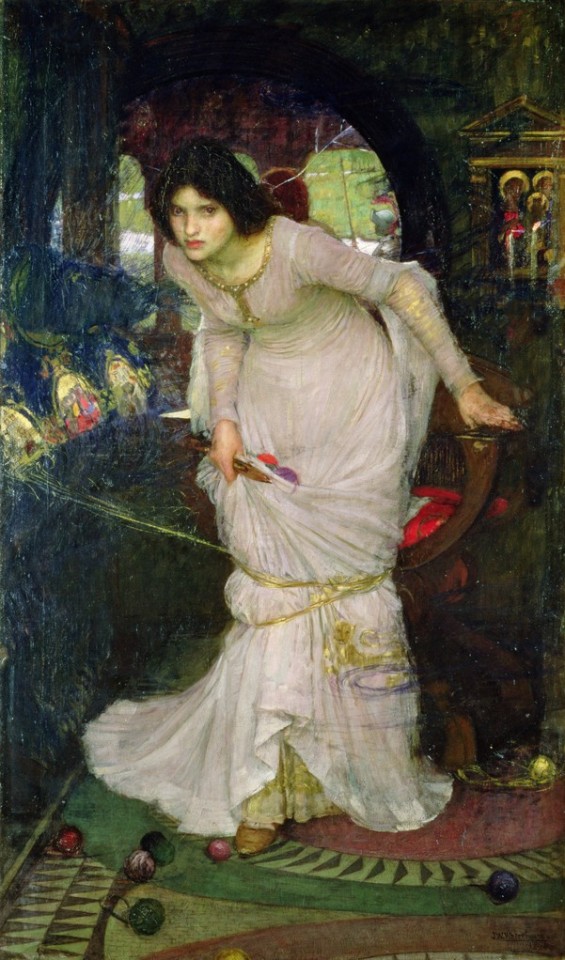

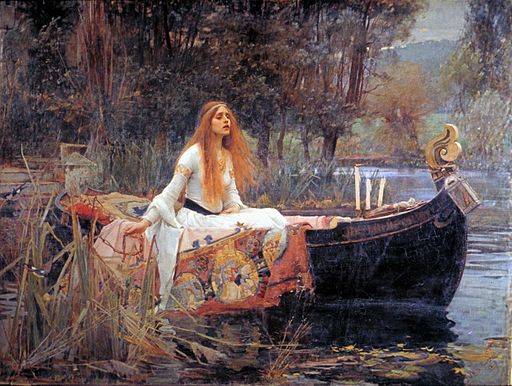
Part I
On either side the river lie
Long fields of barley and of rye,
That clothe the wold and meet the sky;
And thro' the field the road runs by
To many-tower'd Camelot;
The yellow-leaved waterlily
The green-sheathed daffodilly
Tremble in the water chilly
Round about Shalott.
Willows whiten, aspens shiver.
The sunbeam showers break and quiver
In the stream that runneth ever
By the island in the river
Flowing down to Camelot.
Four gray walls, and four gray towers
Overlook a space of flowers,
And the silent isle imbowers
The Lady of Shalott.
Underneath the bearded barley,
The reaper, reaping late and early,
Hears her ever chanting cheerly,
Like an angel, singing clearly,
O'er the stream of Camelot.
Piling the sheaves in furrows airy,
Beneath the moon, the reaper weary
Listening whispers, ' 'Tis the fairy,
Lady of Shalott.'
The little isle is all inrail'd
With a rose-fence, and overtrail'd
With roses: by the marge unhail'd
The shallop flitteth silken sail'd,
Skimming down to Camelot.
A pearl garland winds her head:
She leaneth on a velvet bed,
Full royally apparelled,
The Lady of Shalott.
Part II
No time hath she to sport and play:
A charmed web she weaves alway.
A curse is on her, if she stay
Her weaving, either night or day,
To look down to Camelot.
She knows not what the curse may be;
Therefore she weaveth steadily,
Therefore no other care hath she,
The Lady of Shalott.
She lives with little joy or fear.
Over the water, running near,
The sheepbell tinkles in her ear.
Before her hangs a mirror clear,
Reflecting tower'd Camelot.
And as the mazy web she whirls,
She sees the surly village churls,
And the red cloaks of market girls
Pass onward from Shalott.
Sometimes a troop of damsels glad,
An abbot on an ambling pad,
Sometimes a curly shepherd lad,
Or long-hair'd page in crimson clad,
Goes by to tower'd Camelot:
And sometimes thro' the mirror blue
The knights come riding two and two:
She hath no loyal knight and true,
The Lady of Shalott.
But in her web she still delights
To weave the mirror's magic sights,
For often thro' the silent nights
A funeral, with plumes and lights
And music, came from Camelot:
Or when the moon was overhead
Came two young lovers lately wed;
'I am half sick of shadows,' said
The Lady of Shalott.
Part III
A bow-shot from her bower-eaves,
He rode between the barley-sheaves,
The sun came dazzling thro' the leaves,
And flam'd upon the brazen greaves
Of bold Sir Lancelot.
A red-cross knight for ever kneel'd
To a lady in his shield,
That sparkled on the yellow field,
Beside remote Shalott.
The gemmy bridle glitter'd free,
Like to some branch of stars we see
Hung in the golden Galaxy.
The bridle bells rang merrily
As he rode down from Camelot:
And from his blazon'd baldric slung
A mighty silver bugle hung,
And as he rode his armour rung,
Beside remote Shalott.
All in the blue unclouded weather
Thick-jewell'd shone the saddle-leather,
The helmet and the helmet-feather
Burn'd like one burning flame together,
As he rode down from Camelot.
As often thro' the purple night,
Below the starry clusters bright,
Some bearded meteor, trailing light,
Moves over green Shalott.
His broad clear brow in sunlight glow'd;
On burnish'd hooves his war-horse trode;
From underneath his helmet flow'd
His coal-black curls as on he rode,
As he rode down from Camelot.
From the bank and from the river
He flash'd into the crystal mirror,
'Tirra lirra, tirra lirra:'
Sang Sir Lancelot.
She left the web, she left the loom
She made three paces thro' the room
She saw the water-flower bloom,
She saw the helmet and the plume,
She look'd down to Camelot.
Out flew the web and floated wide;
The mirror crack'd from side to side;
'The curse is come upon me,' cried
The Lady of Shalott.
Part IV
In the stormy east-wind straining,
The pale yellow woods were waning,
The broad stream in his banks complaining,
Heavily the low sky raining
Over tower'd Camelot;
Outside the isle a shallow boat
Beneath a willow lay afloat,
Below the carven stern she wrote,
The Lady of Shalott.
A cloudwhite crown of pearl she dight,
All raimented in snowy white
That loosely flew (her zone in sight
Clasp'd with one blinding diamond bright)
Her wide eyes fix'd on Camelot,
Though the squally east-wind keenly
Blew, with folded arms serenely
By the water stood the queenly
Lady of Shalott.
With a steady stony glance—
Like some bold seer in a trance,
Beholding all his own mischance,
Mute, with a glassy countenance—
She look'd down to Camelot.
It was the closing of the day:
She loos'd the chain, and down she lay;
The broad stream bore her far away,
The Lady of Shalott.
As when to sailors while they roam,
By creeks and outfalls far from home,
Rising and dropping with the foam,
From dying swans wild warblings come,
Blown shoreward; so to Camelot
Still as the boathead wound along
The willowy hills and fields among,
They heard her chanting her deathsong,
The Lady of Shalott.
A longdrawn carol, mournful, holy,
She chanted loudly, chanted lowly,
Till her eyes were darken'd wholly,
And her smooth face sharpen'd slowly,
Turn'd to tower'd Camelot:
For ere she reach'd upon the tide
The first house by the water-side,
Singing in her song she died,
The Lady of Shalott.
Under tower and balcony,
By garden wall and gallery,
A pale, pale corpse she floated by,
Deadcold, between the houses high,
Dead into tower'd Camelot.
Knight and burgher, lord and dame,
To the planked wharfage came:
Below the stern they read her name,
The Lady of Shalott.
They cross'd themselves, their stars they blest,
Knight, minstrel, abbot, squire, and guest.
There lay a parchment on her breast,
That puzzled more than all the rest,
The wellfed wits at Camelot.
'The web was woven curiously,
The charm is broken utterly,
Draw near and fear not,—this is I,
The Lady of Shalott.'
Lord Alfred Tennyson - "Works" - 1832
Paintings : various portraits of the Lady of Shalott by John William Waterhouse
#poésie#poetry#the lady of shalott#tennyson#lord alfred tennyson#paintings#john william waterhouse#waterhouse#pre raphaelism#pre raphaelite#poem#val loves poetry
12 notes
·
View notes
Note
Do you have any recommendations for someone trying to get into poetry? All I've read so far is some Lagston Hughes and Edgar Allan Poe stuff. Like not even specific types just poetry.
I TOO STRUGGLE WITH POETRY! I AM A PROSE GIRL THROUGH AND THROUGH. I do have a deep appreciation for the poetry and those who enjoy it, though, so your interest is commendable and I love that you want to get into it.
but, basically, my favorites are the old guys from england
Willy Shakes, probably my all time favorite poet, from his plays to his sonnets, love pretty much everything he does.
Let me not to the marriage of true minds
Admit impediments. Love is not love
Which alters when it alteration finds,
Or bends with the remover to remove:
O no! it is an ever-fixed mark
That looks on tempests and is never shaken;
It is the star to every wandering bark,
Whose worth's unknown, although his height be taken.
Love's not Time's fool, though rosy lips and cheeks
Within his bending sickle's compass come:
Love alters not with his brief hours and weeks,
But bears it out even to the edge of doom.
If this be error and upon me proved,
I never writ, nor no man ever loved.
Just. Vibes. Yeah. I love it. So much.
I love Tennyson. I'm a fool for him. I love is style, I love his writing. It's beautiful.
But in her web she still delights
To weave the mirror's magic sights,
For often thro' the silent nights
A funeral, with plumes and lights
And music, came from Camelot:
Or when the moon was overhead
Came two young lovers lately wed;
'I am half sick of shadows,' said
The Lady of Shalott.
it's just so pure and crystal clear and i live for that kind of poetry, honestly. The simple, clean way of speaking through the poetry really makes me happy. I know a lot of people don't necessarily read poetry like i do(very literally. i love deep meanings but when it comes to poetry i usually aim for the most literal sense i can grasp).
Emily Dickinson is amazing, Henry Wadsworth Longfellow is so good with words. Keats is good if you like pages and pages of flowers. Literal flowers. I enjoy that on occasion. Robert Frost makes me want to take a nap either in the sunshine or cuddled up under a blanket. I love his poetry. Elizabeth Butler isn't bad, although she's not my favorite. T. S. Elliot makes me want to write kotlc dystopian fanfiction. I could live and die in the discussion of religion and progressivism that Wallace Steven's Sunday Morning poem brings up.
I would say to stay away from poets who don't have any sort of rhyme scheme or meter. They bug me on an intellectual level. It's like, why are you writing your prose all chopped up. Like. If you're gonna write flowery short form prose write that. Don't pretend it's poems. Idk. People are welcome to their opinions and this is mine. I'll die on this stupid highbrow hill of what I think makes poetry poetry.
But yeah. These are some of my favorite poets! I hope you like what you find of them!
Also. Langston Hughes. 10/10. Love his stuff. Poe is good too. They're both excellent picks, imho. :D
#hope you enjoy!#thanks for the ask!#not fandom content#english major rant#poetry#william shakespeare#alfred lord tennyson#tennyson#shakespeare#robert frost#poets#thoughts on poetry
17 notes
·
View notes
Text
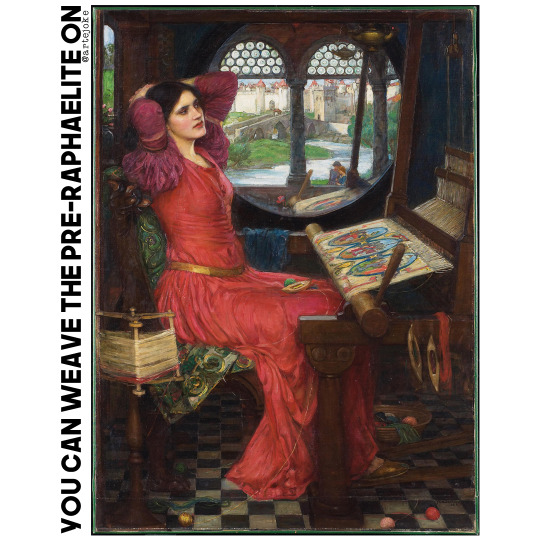
You can weave the Pre-Raphaelite on
John William Waterhouse, I am half-sick of shadows, said the lady of Shalott, 1915, Art Gallery of Ontario
#art history#art history memes#art meme#dad jokes#punny#puns#punsarelikeonions#women in art#history memes#museum nerd#weaving#handloomday
2 notes
·
View notes